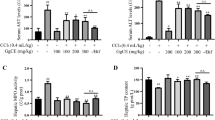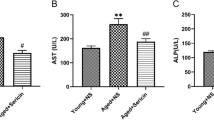Abstract
Cellular glutathione antioxidant system plays important roles in counteracting hepatotoxins-induced oxidative stress injury. The present study was designed to observe the differences of this system in newly weaned and young mice liver and its involvement in the susceptibility to isoline-induced liver injury. Our results showed that liver reduced glutathione (GSH) amounts were higher in newly weaned mice than young mice. Glutamate-cysteine ligase (GCL) activity was higher in newly weaned mice due to the higher expression of catalytic subunit of GCL (GCLC) protein and mRNA. However, the activities of glutathione reductase (GR), glutathione peroxidase (GPx), and glutathione-S-transferase (GST) were higher in young mice liver, which might be due to the higher expression of GR, GPx-1, and GST-Pi proteins. Next, the results of AST analysis and histopathological evaluation showed that newly weaned mice demonstrated more severe liver injury induced by isoline. Furthermore, liver GSH amounts and the activities of GR, GPx, and GST were all lower in newly weaned mice than young mice after treated with isoline. Depletion of cellular GSH by d,l-buthionine-(S, R)-sulfoximine (BSO) aggravated isoline-induced cytotoxicity, while N-acetyl-l cysteine (NAC) ameliorated such cytotoxicity. Furthermore, the inhibitors of GR, GPx, and GST all aggravated isoline-induced cytotoxicity. In conclusion, our results demonstrated the differences of glutathione antioxidant system between newly weaned and young mice liver. Meanwhile, our results also revealed age-dependent liver injury induced by isoline for the first time, which might be due to the different responses of glutathione antioxidant system to isoline between newly weaned and young mice.









Similar content being viewed by others
Abbreviations
- GSH:
-
Reduced glutathione
- GSSG:
-
Oxidized glutathione
- GCL:
-
Glutamate-cysteine ligase
- GR:
-
Glutathione reductase
- GPx:
-
Glutathione peroxidase
- GST:
-
Glutathione-S-transferase
- NAC:
-
N-acetyl-l cysteine
- ROS:
-
Reactive oxygen species
- DILI:
-
Drug-induced liver injury
- LPS:
-
Lipopolysaccharide
- PAs:
-
Pyrrolizidine alkaloids
- DTNB:
-
5, 5′-Dithio-bis (2-nitrobenzoic acid)
- BCNU:
-
1,3-Bis(2-chloroethyl)-1-nitrourea
- BSO:
-
d,l-buthionine-(S, R)-sulfoximine
- MA:
-
Mercaptosuccinic acid
- EA:
-
Ethacrynic acid
- CDNB:
-
1-Chloro-2, 4-dinitrophenol
- RT-PCR:
-
Reverse transcription-polymerase chain reaction
- MTT:
-
3-(4, 5-Dimethyl-thiazol-2-yl) 2, 5-diphenyltetra-zolium bromide
- AST:
-
Aspartate aminotransferase
References
Allameh A, Vansoun E, Zarghi A (1997) Role of glutathione conjugation in protection of weanling rat liver against acetaminophen-induced hepatotoxicity. Mech Ageing Dev 95:71–79
Al-Rawi M (2007) Inhibitory effect of melatonin on histological changes induced in rat liver by thioacetamide intoxication. J Biol Sci 7:10–18
Bammler T, Smith C, Wolf C (1994) Isolation and characterization of two mouse Pi-class glutathione S-transferase genes. Biochem J 298:385–390
Bradford M (1976) A rapid and sensitive method for the quantitation of microgram quantities of protein utilizing the principle of protein-dye binding. Anal Biochem 72:248–254
Carlberg I, Mannervik B (1985) Glutathione reductase. Methods Enzymol 113:484–490
Chaudiere J, Wilhelmsen EC, Tappel AL (1984) Mechanism of selenium-glutathione peroxidase and its inhibition by mercaptocarboxylic acids and other mercaptans. J Biol Chem 259:1043–1050
Cho H, Jedlicka A, Reddy S, Kensler T, Yamamoto M, Zhang L, Kleeberger S (2002) Role of NRF2 in protection against hyperoxic lung injury in mice. Am J Respir Cell Mol Biol 26:175–182
Deleve LD, Kaplowitz N (1991) Glutathione metabolism and its role in hepatotoxicity. Pharmacol Ther 52:287–305
Durham S, Brouwer A, Barelds R, Horan M, Knook D (1990) Comparative endotoxin-induced hepatic injury in young and aged rats. J Pathol 162:341–349
El Mouatassim S, Guerin P, Menezo Y (1999) Expression of genes encoding antioxidant enzymes in human and mouse oocytes during the final stages of maturation. Mol Hum Reprod 5:720–725
Fu P, Xia Q, Lin G, Chou M (2004) Pyrrolizidine alkaloids-genotoxicity, metabolism enzymes, metabolic activation, and mechanisms. Drug Metab Rev 36:1–55
Geier DA, Kern JK, Garver CR, Adams JB, Audhya T, Nataf R, Geier MR (2009) Biomarkers of environmental toxicity and susceptibility in autism. J Neurol Sci 280:101–108
Griffith OW (1999) Biologic and pharmacologic regulation of mammalian glutathione synthesis. Free Radic Biol Med 27:922–935
Griffith OW, Meister A (1979) Potent and specific inhibition of glutathione synthesis by buthionine sulfoximine (S-n-butyl homocysteine sulfoximine). J Biol Chem 254:7558–7560
Habig WH, Jakoby WB (1981) Assays for differentiation of glutathione S-transferases. Methods Enzymol 77:398–405
Hansen M, Nielsen S, Berg K (1989) Re-examination and further development of a precise and rapid dye method for measuring cell growth/cell kill. J Immunol Methods 119:203–210
Hansson J, Berhane K, Castro VM, Jungnelius U, Mannervik B, Ringborg U (1991) Sensitization of human melanoma cells to the cytotoxic effect of melphalan by the glutathione transferase inhibitor ethacrynic acid. Cancer Res 51:94–98
Hatano E, Bradham C, Stark A, Iimuro Y, Lemasters J, Brenner D (2000) The mitochondrial permeability transition augments Fas-induced apoptosis in mouse hepatocytes. J Biol Chem 275:11814–11823
Husain K, Somani S (1997) Interaction of exercise and ethanol on hepatic and plasma antioxidant system in rat. Pathophysiology 4:69–74
Ji L, Liu T, Chen Y, Wang Z (2009) Protective mechanisms of N-acetyl-cysteine against pyrrolizidine alkaloid clivorine-induced hepatotoxicity. J Cell Biochem 108:424–432
Jopperi-Davis KS, Park MS, Rogers LK, Backes CH, Lim IK Jr, Smith CV (2004) Compartmental inhibition of hepatic glutathione reductase activities by 1, 3-bis(2-chloroethyl)-N-nitrosourea (BCNU) in Sprague-Dawley and Fischer-344 rats. Toxicol Lett 147:219–228
Kim SG, Chung HC, Cho JY (1996) Molecular mechanism for alkyl sulfide-modulated carbon tetrachloride-induced hepatotoxicity: the role of cytochrome P450 2E1, P450 2B and glutathione S-transferase expression. J Pharmacol Exp Ther 277:1058–1066
Kim J, Li S, GrandPre T, Qiu D, Strittmatter S (2003) Axon regeneration in young adult mice lacking Nogo-A/B. Neuron 38:187–199
Lei XG, Cheng WH (2005) New roles for an old selenoenzyme: evidence from glutathione peroxidase-1 null and overexpressing mice. J Nutr 135:2295–2298
Leung L, Kwong M, Hou S, Lee C, Chan J (2003) Deficiency of the Nrf 1 and Nrf 2 transcription factors results in early embryonic lethality and severe oxidative Stress. J Biol Chem 278:48021–48029
Liu R, Choi J (2000) Age-associated decline in gamma-glutamylcysteine synthetase gene expression in rats. Free Radic Biol Med 28:566–574
Liu T, Chen Y, Wang Z, Ji L, Wang Z (2010) Pyrrolizidine alkaloid isoline-induced oxidative injury in various mouse tissues. Exp Toxicol Pathol 62:251–257
Lucena M, Andrade R, Kaplowitz N, Garcia-Cortes M, Fernandez M, Romero-Gomez M, Bruguera M, Hallal H, Robles-Diaz M, Rodriguez-Gonzalez J (2009) Phenotypic characterization of idiosyncratic drug-induced liver injury: the influence of age and sex. Hepatology 49:2001–2009
Mannervik B, Awasthi Y, Board P, Hayes J, Di Ilio C, Ketterer B, Listowsky I, Morgenstern R, Muramatsu M, Pearson W (1992) Nomenclature for human glutathione transferases. Biochem J 282:305–306
McConnachie LA, Mohar I, Hudson FN, Ware CB, Ladiges WC, Fernandez C, Chatterton-Kirchmeier S, White CC, Pierce RH, Kavanagh TJ (2007) Glutamate cysteine ligase modifier subunit deficiency and gender as determinants of acetaminophen-induced hepatotoxicity in mice. Toxicol Sci 99:628–636
Morishita K, Mizukawa Y, Kasahara T, Okuyama M, Takashima K, Toritsuka N, Miyagishima T, Nagao T, Urushidani T (2006) Gene expression profile in liver of differing ages of rats after single oral administration of acetaminophen. J Toxicol Sci 31:491–507
Penninckx M (2000) A short review on the role of glutathione in the response of yeasts to nutritional, environmental, and oxidative stresses. Enzyme Microb Technol 26:737–742
Reitman S, Frankel S (1957) A colorimetric method for the determination of serum glutamic oxalacetic and glutamic pyruvic transaminases. Am J Clin Pathol 28:56–63
Rikans L, DeCicco L, Hornbrook K, Yamano T (1999) Effect of age and carbon tetrachloride on cytokine concentrations in rat liver. Mech Ageing Dev 108:173–182
Rotruck J, Pope A, Ganther H, Swanson A, Hafeman D, Hoekstra W (1973) Selenium: biochemical role as a component of glutathione peroxidase. Science 179:588–590
Sanz N, Diez-Fernandez C, Alvarez A, Cascales M (1997) Age-dependent modifications in rat hepatocyte antioxidant defense systems. J Hepatol 27:525–534
Sanz N, Diez-Fernandez C, Fernandez-Simon L, Alvarez A, Cascales M (1998) Necrogenic and regenerative responses of liver of newly weaned rats against a sublethal dose of thioacetamide. Biochim Biophys Acta 1384:66–78
Seelig G, Simondsen R, Meister A (1984) Reversible dissociation of gamma-glutamylcysteine synthetase into two subunits. J Biol Chem 259:9345–9347
Sies H, Akerboom T (1984) Glutathione disulfide (GSSG) efflux from cells and tissues. Methods Enzymol 105:445–451
Tappel A (1978) Glutathione peroxidase and hydroperoxides. Method Enzymol 52:506–513
Thurston J, Hauhart R (1992) Amelioration of adverse effects of valproic acid on ketogenesis and liver coenzyme A metabolism by cotreatment with pantothenate and carnitine in developing mice: possible clinical significance. Pediatr Res 31:419–423
Wong H, Fricker M, Wyttenbach A, Villunger A, Michalak E, Strasser A, Tolkovsky A (2005) Mutually exclusive subsets of BH3-only proteins are activated by the p53 and c-Jun N-terminal kinase/c-Jun signaling pathways during cortical neuron apoptosis induced by arsenite. Mol Cell Biol 25:8732–8747
Yamano T, Shimizu M, Noda T (1998) Age-related change in cadmium-induced hepatotoxicity in Wistar rats: role of Kupffer cells and neutrophils. Toxicol Appl Pharmacol 151:9–15
Zhang H, Court N, Forman J (2007) Submicromolar concentrations of 4-hydroxynonenal induce glutamate cysteine ligase expression in HBE1 cells. Redox Rep 12:101–106
Zheng S, Yumei F, Chen A (2007) De novo synthesis of glutathione is a prerequisite for curcumin to inhibit hepatic stellate cell (HSC) activation. Free Radic Biol Med 43:444–453
Acknowledgments
This work was financially supported by National Natural Science Foundation of China (30801544), National Basic Research Program Foundation of China (2006CB504704), Innovation Program of Shanghai Municipal Education Commission (09ZZ125), and Shanghai Rising-Star Program (10QH1402200).
Author information
Authors and Affiliations
Corresponding authors
Rights and permissions
About this article
Cite this article
Liang, QN., Sheng, YC., Jiang, P. et al. The difference of glutathione antioxidant system in newly weaned and young mice liver and its involvement in isoline-induced hepatotoxicity. Arch Toxicol 85, 1267–1279 (2011). https://doi.org/10.1007/s00204-011-0664-7
Received:
Accepted:
Published:
Issue Date:
DOI: https://doi.org/10.1007/s00204-011-0664-7




